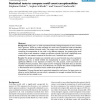BMCBI
2007
14 years 18 days ago
2007
BMCBI
2007
14 years 18 days ago
2007
Background: Research in evolution requires software for visualizing and editing phylogenetic trees, for increasingly very large datasets, such as arise in expression analysis or m...
BMCBI
2007
14 years 18 days ago
2007
Background: Finding over- or under-represented motifs in biological sequences is now a common task in genomics. Thanks to p-value calculation for motif counts, exceptional motifs ...
BMCBI
2007
14 years 18 days ago
2007
Background: There exist many segmentation techniques for genomic sequences, and the segmentations can also be based on many different biological features. We show how to evaluate ...
BMCBI
2007
14 years 18 days ago
2007
Background: The problem of protein structure prediction consists of predicting the functional or native structure of a protein given its linear sequence of amino acids. This probl...
BMCBI
2007
14 years 18 days ago
2007
Background: The Sulston score is a well-established, though approximate metric for probabilistically evaluating postulated clone overlaps in DNA fingerprint mapping. It is known t...
BMCBI
2007
14 years 18 days ago
2007
Background: Array comparative genome hybridization (aCGH) provides information about genomic aberrations. Alterations in the DNA copy number may cause the cell to malfunction, lea...
BMCBI
2007
14 years 18 days ago
2007
Background: Identifying relevant research in an ever-growing body of published literature is becoming increasingly difficult. Establishing domain-specific knowledge bases may be a...
BMCBI
2007
14 years 18 days ago
2007
Background: Gene-set analysis evaluates the expression of biological pathways, or a priori defined gene sets, rather than that of individual genes, in association with a binary ph...
BMCBI
2007
14 years 18 days ago
2007
Background: The Affymetrix GeneChip technology uses multiple probes per gene to measure its expression level. Individual probe signals can vary widely, which hampers proper interp...




